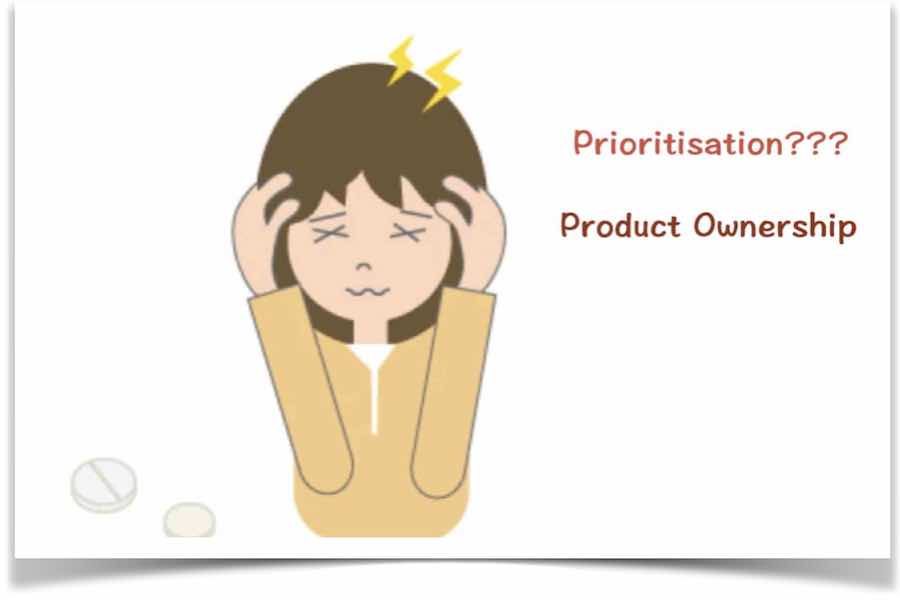Everybody talks about prioritization, but, hold on a sec, what does that exactly mean? How do we prioritize?
First, before we talk about prioritization, let’s make sure you are actually using some methods to prioritize. There is a long list of prioritization frameworks that we can use, which includes Kano model, business value, risks and value, MOSCOW, and there are more frameworks.
What do you use for your product? Hopefully you are using some prioritization methods but not HIPPO (HIghest-Paid Person’s Opinion – when priorities are set by position power, by senior management based on their “professional” gut and experience), and not LSP (Loudest Scream Prioritization) either.
You may have heard from Evelyn during her workshops and mentoring sessions that Prioritization is an art.
While it may be an art to work with HIPPO or LSP (just joking), prioritization is really an art. How so?
There is a long list of prioritization methods and practices. There are also pros and cons of each, and its applicable context. And your situation is always very unique. Each product is unique in many different ways – type of product, product characteristics, product strategy, product’s eco system, product constraints, and more. The list is long, and very long.
Prioritizing product backlog is a simple phrase to talk about, but landing it in action is never easy in practice. There is a long list of challenges, and below you can find a couple:

How to define business value?
Everybody talks about business value, but everybody has their unique definition. Defining what constitutes business value can be challenging, as it may vary depending on the organization’s goals, stakeholders, industry, product strategy, and more. It can be difficult to measure or quantify the value of certain items, making it challenging to prioritize them effectively.
How to balance competing priorities?
Business value is just one of many factors that Product Owners need to consider during prioritization. Balancing competing priorities such as user needs, technical feasibility, cost reduction strategy, and various constraints can make it challenging to prioritize backlog items based solely on business value.
How to work with uncertainties?
We don’t quite like uncertainties but we live in the VUCA world. If you have to draw the cone of uncertainty for your product, how would it look like? Uncertainty can impact the ability to accurately assess business value, estimate cost, forecast technology challenges, and more.
Market can be dynamic for many products. How would new market trends, changing customer preferences, or emerging technologies affect the product situation, which makes it even challenging prioritise effectively.
How do we reflect different goals to achieve in the months to come?
Market is changing, and competitors are moving. Our strategy is adjusting. Therefore, prioritization needs to evolving also, and value definition evolves also.
And there are many other challenges and areas to look into.
Some simple antidotes include the following:
Defining business value clearly – work with stakeholders to define what constitutes business value for the organization, the product, the strategy and align. Then you can co-create and define ways of measuring as well.
Balancing priorities – balance competing priorities such as user needs, technical feasibility, cost reduction strategy, and various constraints. Utilise a range of techniques to ensure that all factors are taken into account.
Embracing uncertainties – acknowledge there is a list of uncertainties, and actively work with uncertainties. Work with data driven decision making and benefit from product discovery to actively reduce uncertainties.
Of course, if you haven’t experimented any prioritization techniques yet, the very first step is to understand what type of product you have, what can be a good step moving forward to prioritization, what experiment you want to run to validate your assumptions, and how to continuously improve for better prioritization.
Empty space, drag to resize
In our Advanced Certified Scrum Product Owner (A-CSPO) workshop, you will get to take a deeper dive into prioritization and of course many other subjectives, including Evelyn’s unique 4-D stakeholder related tools, hypothesis driven product development, roadmap design, product metrics and more.
You will be working with Evelyn Tian, who has solid hands-on product manager experience, product management for large complex products, and has been mentoring product, and product professionals across different industrials.
As a coach and a trainer with solid product experience, she facilitates her product related workshops in her very unique way, and has supported product professionals through mentoring and training.
Want to advance Agile product Ownership, check out our offerings on the entire product path.


